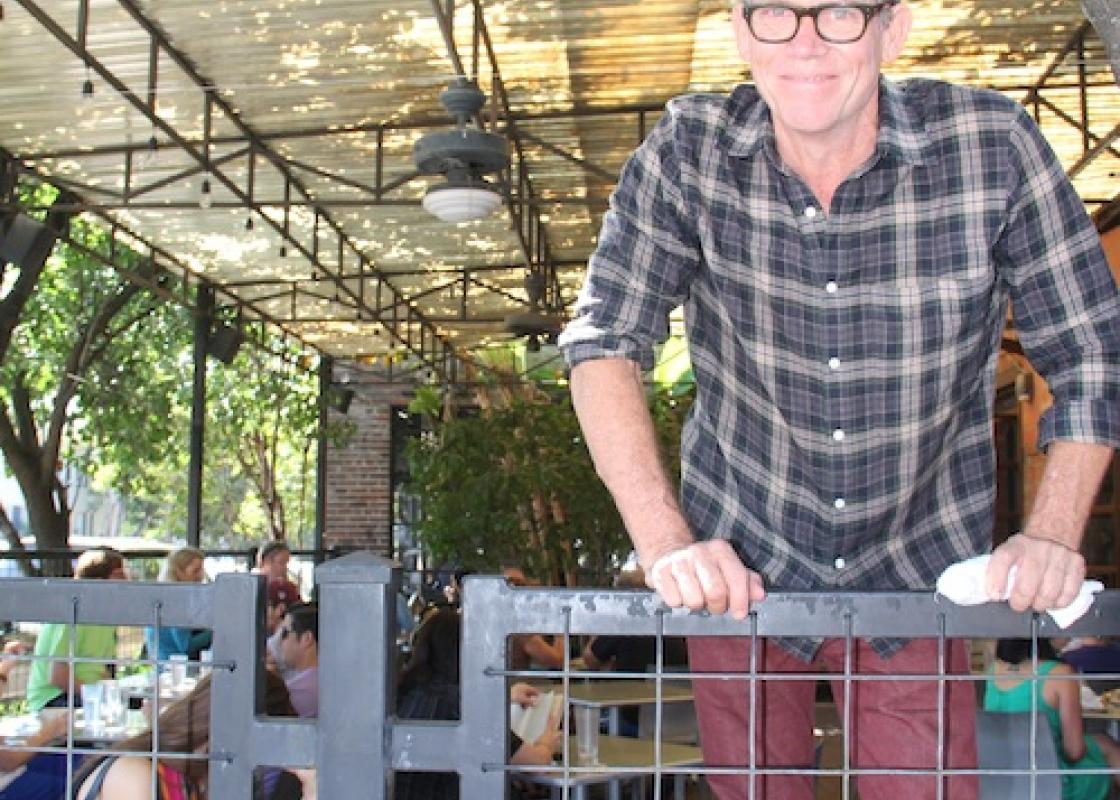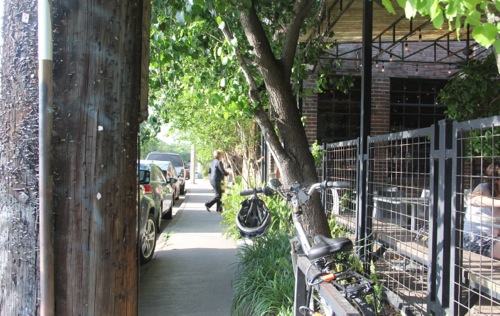
View down Dunlavy from Westheimer. Photograph by Raj Mankad.
It’s true that rents are rising in Montrose, and the writers, artists, and other freaks are in retreat. But I am still in love with the neighborhood. I still love its best street---Lower Westheimer. I refuse to relinquish its rich countercultures. And I believe the Sunday Street on May 4, from 11 a.m. to 3 p.m., along Westheimer between McDuffie and Yoakum, will help sustain the spirit of the neighborhood, keeping open space not just for fine dining but for weirdness and difference.
Of the many antique shops, tattoo parlors, bars, restaurants, and cafes along that route, today I praise Cafe Brasil and its owner.
First of all, I love the approach to Brasil. I often walk there from Kipling Street. Shade trees are plenty, as are bungalows with generous porches. What I love most about the walk, however, are the utility poles that pierce the middle of the narrow sidewalks down Dunlavy and that force strangers into an intimate dance. More tango than ballet, you must squeeze in your belly as young men and women in skinny jeans scoot by.
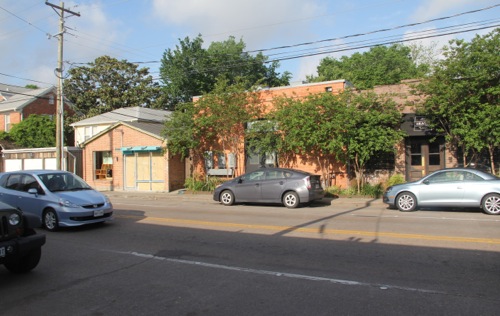
Cafe Brasil entrance on Dunlavy. Photograph by Raj Mankad.
When you open the door, a snaking line from the counter greets you. I love this line too. The mix of people is entertaining, a rotation of characters through the day. Gaggles of teens, all nervous laughter, their first Montrose adventure. Bleary-eyed graduate students with books in hand. Families in which each parent speaks to their child in a different language. Mexican millionaires taking a break from their shopping sprees. And dates, so very many dates, zipped and buttoned into their tightest.
The interior is simple. Unpolished concrete floors, bare brick walls, and exposed wooden trusses. It feels right, but not “design-y.” Its owner, however, is a designer and graduated from architecture school at the University of Texas. The story of how Dan Fergus came to start the cafe, and expand it, captures some breathtaking changes in Houston and reveals how a trained architect can have an impact outside of traditional practice.
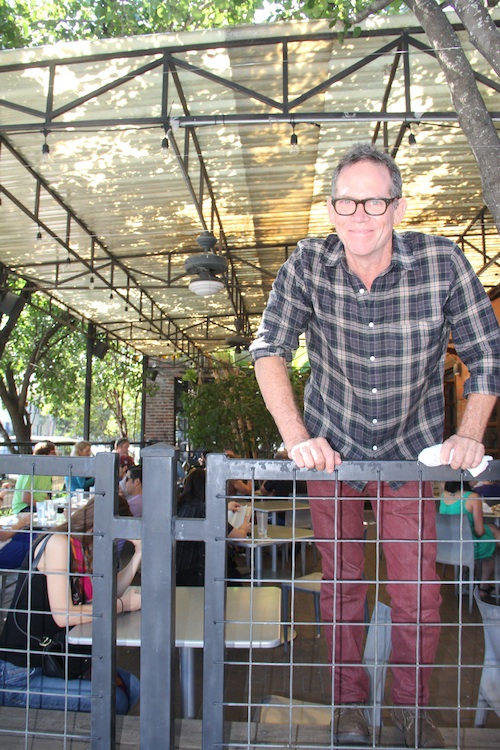
Dan Fergus at Cafe Brasil. Photograph by Raj Mankad.
“I grew up in Houston in the suburbs --- in Sharpstown, when it used to be the edge of town,” Fergus says. It was the '70s. He describes the world of malls and rows of ticky-tacky houses as “less than inspiring.” At the same time, he didn’t quite know what he was missing. He says, “It was scary to think of a Downtown. Every image of New York was frightening.”
He graduated from high school early and worked in construction. “I really appreciated the way things went together,” he says, and “wasn’t really planning to go to college.” Until, that is, summer rolled around. “I kept seeing this guy get out of his car on 100-degree days with some plans and then he’d get back in the [air-conditioned] car.”
Fergus completed his degree at the University of Texas in the early '80s. He worked in Los Angeles for five years at architecture firms, including a brief stint building models for Frank Gehry. Ultimately, his frustrations with architecture firms mounted. Projects with good clients were rare.
“I soon realized not everyone can be this amazing designer and be in magazines,” he says. When the 1988 recession hit and the bottom fell out of the building industry, Fergus began looking for alternatives. A friend invited him on a sailing trip. He packed up his belongings and stored them in Houston. The voyage took him to Brazil. “Thought I’d be there two weeks, ended up staying a year,” he says. His plan, upon returning to Houston in 1989, was to open a gallery selling Brazilian outsider art.
The first location Fergus opened to sell art was on the Westheimer curve in the little building that now houses a spy gadgets store (Catch a cheating spouse!). He worked construction to pay his bills. The current location of Cafe Brasil was, at the time, a Schwinn bicycle shop. “I found out he was closing up,” Fergus says. “The old guy had been there for 40 years.”
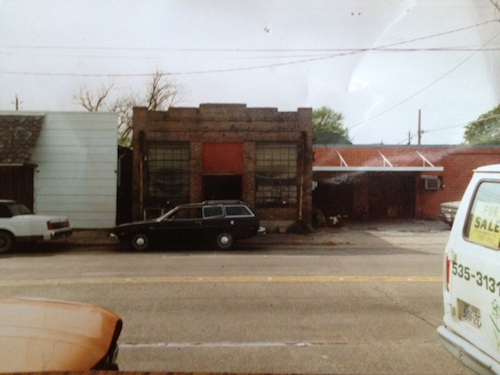
Site of Cafe Brasil before renovation. Photograph courtesy Dan Fergus.
After finding the building owners through the Harris County Appraisal District, Fergus negotiated a lease at $600 per month. He began remodeling the place thinking he would open a larger gallery. The way he talks about the process, it is as if the building suggested that a cafe would be a better idea.
“The desire to do the cafe was as much an architectural decision as it was a business one,” Fergus says. In his estimation, the only cafes open at the time were House of Pies and a short-lived place called Downtown Brown. Cafe Brasil opened in April 1992.
Over time, Fergus bought the location and the adjacent property. He installed a wall of windows opening onto a street-facing patio where there was once a garage bay. The duplex next door became DOMY bookstore and recently The Brandon gallery. The combined yards became a courtyard back patio with a screen for film showings.
The sequence to the back patio is like the narrow sidewalk on Dunlavy. You squeeze through a little hall lined with posters and fliers, push through a door into a little alley, and turn the corner into the shady courtyard—all this creates a feeling of discovery and intimacy.
Many of the spaces along Westheimer that could have been, or once were, like the gallery and back patio of Brasil are now parking lots. In “Westheimer on Foot: Home of the Hip, Walk of the Brave,” David Theis writes, “While some old buildings have happily been converted into temples of gastronomy, others have been leveled to create surface lots to meet mandated parking requirements.” As a result, we get what Philip Lopate calls Houston’s “gap-toothed smile.”
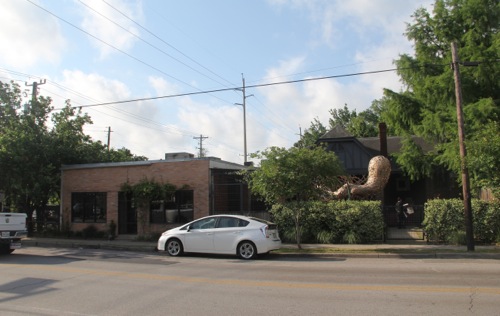
Cafe Brasil and The Brandon on Westheimer. Photograph by Raj Mankad.
A large majority of people who live inside the City of Houston say they want to be able to walk to markets and restaurants, but we have long elected officials who expand parking requirements, making the creation of Brasil-like places very difficult to accomplish, if not illegal.
Theis writes, “Westheimer should be a great promenade.” He’s not the only one to think so, as we learned when my petition calling for Sunday Streets quickly garnered 1,000 signatures and an endorsement from the Houston Chronicle.
On Sunday May 4, we have the opportunity to experience Westheimer as a promenade for a few hours. Cafe Brasil will be among the great sites on the route. Though I love the cramped sidewalk on Dunlavy, I’m very excited that pedestrians, cyclists, unicyclists, wheel chair users, skate boarders, and others will fill the street. I’m excited that Fergus plans to open his gates along Westheimer, sell refreshments from the gallery’s front porch, and line up live music.
I hope to see you there.


